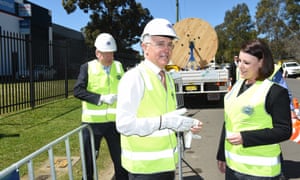Extract from The Guardian
Most Australians believe that the internet is an essential service
like electricity or water, but only one in five believe Malcolm
Turnbull’s model is up to the task


One of the few surviving elements of Malcolm Turnbull’s pre-prime ministerial mythology is that of the dot-com entrepreneur whose mastery of all things digital would give the nation a railroad into the future.
It won’t survive for much longer if new figures published in today’s Essential Report are any guide.
Just as his Q&A leather jacket has not translated into socially progressive garb and his mastery of merchant banking has not armed him to tame the banks, so his apparent technological expertise has failed to download the network solution the nation needs.
As Tony Abbott’s preferred “tech-head”, Turnbull enabled the winding back of Labor’s finer to-the-premises model of a National Broadband Network, to a cheaper system that relied on the existing copper wiring to deliver services to the home.
Even three years ago, the difference between the models seemed largely theoretical – both systems seemed to deliver faster downloads of “the Internet”. Labor’s was just faster.
But changes in everyday usage over that period have given the electorate a lived experience of what broadband capacity actually means.
As the smart TV has become ubiquitous and video stores have gone the way of the record store, homes are in constant download with streams of content squeezing through the pipes.
Those who actually upload content – particularly video – are inventing new words to describe the time spent staring at a screen and waiting for the files to land.
Meanwhile those in the business of transferring large parcels of information, or even trying to organise an online video conference, know the quality of the service can be the difference between closing a deal or not.
The point is that the NBN has gone from being seen as a shiny new toy to a basic necessity:
This has been his consistent position through his time as prime minister, promising an NBN that was “Fast. Affordable. Sooner”, despite the reality of delays, cost-blowouts and lingering doubts over the technology being deployed.
While the roll out unravels so does public faith in the platform, with just one in five Australians believing the Turnbull model will provide even an “adequate” service to meet the nation’s future needs.
And remember, for voters this is now regarded as an essential service, on a par with water and power supplies. Imagine the angst – and jolt to political action – if you replaced the word “internet” with “power” or “water” in the above question.
That reflects the view in our final question, that sees the opposition seizing control of the issue from the prime minister, with a majority of voters believing it would be in the national interest to wait a longer and pay more for Labor’s full fibre rollout.
For Malcolm Turnbull the NBN goes much deeper because it speaks to the core of his political identity: the champion of innovation who wants us all to look across the horizon embrace a glorious future.
It was one of the core themes that failed to bite in the federal election campaign – and there were a few reasons for that.
One, he was too focused on the idea of hip start-ups and angel investors, rather than recognising most innovation is driven through existing businesses dealing with the pressures of change in real time.
Two, he failed to explain to the average worker concerned about job security and worried about being innovated out of their industry and where they would fit into this brave new world.
But most fundamentally, as these figures show, he was telling the Australian public to jump on a thoroughbred when all they see is a donkey.
No comments:
Post a Comment